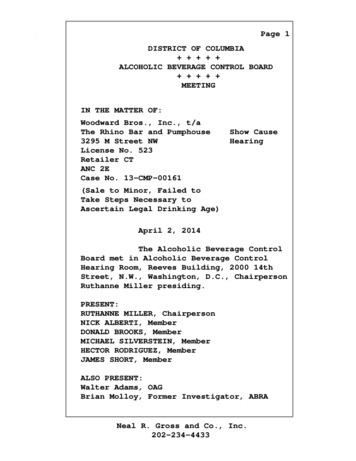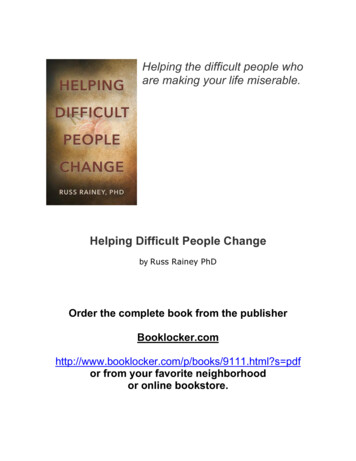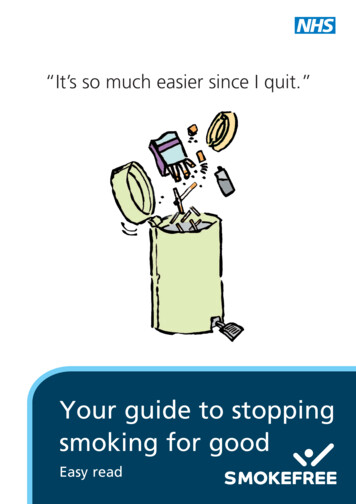
Transcription
StoppingDifficult Peoplefrom Sucking the LifeOut of Your MANCE MANAGEMENTEssentialInsights
Stopping Difficult People from Sucking the Life Out of Your ////////////////////////////////////////////////// Identifying the Three Cs Are you punishing behavior you don’t want – or rewarding it? Helping difficult people to change Riding herd A burr under your saddle Are they indeed difficult people? The 3 Cs of a Difficult Person The ‘What’ is never negotiable; the ‘How’ may be hree Principles of Behavior - Are you rewarding or punishingTunwanted behaviors? Applying it all to Difficult People More on riding herd: Don’t let up until the problem is solved trategies: Applying these techniques to common difficultSbehaviors 4 Principles of Working with People Making ‘disagreeing’ part of the culture Fulfilling needs: Whose job is it, anyway? Managing up: Dealing with difficult superiorsPage 2 / 24370 Technology DriveMalvern, PA 19355610-727-0515 2019 HR MorningAll rights reserved.
Stopping Difficult People from Sucking the Life Out of Your OrganizationStopping Difficult Peoplefrom Sucking the Life Outof Your OrganizationIdentifying the Three CsAre “difficult people” difficult just in the eye of the beholder? No.To identify truly difficult employees, ask yourself these threequestions: Is the person’s behavior really causing a problem? Is the person consistently difficult? Is there a consensus on this?Are you punishing behavior you don’t want – orrewarding it?Most managers know they should reward employees for behaviorthey want to see repeated.But all managers, at one time or another, find themselvesunintentionally rewarding, or at least supporting, problematicbehavior.The key to addressing problem behavior is understanding that: Punishment can work, but rewards work better Behavior that is consistently rewarded tends to be repeated Unrewarded, or unreinforced, behavior tends to disappear. Intermittent reinforcement is more powerful than constantreinforcement.Page 3 / 24370 Technology DriveMalvern, PA 19355610-727-0515 2019 HR MorningAll rights reserved.
Stopping Difficult People from Sucking the Life Out of Your OrganizationHelping difficult people to changeOnce you’ve decided it’s worth making the effort to try to change adifficult person’s behavior, make a commitment to see the processthrough to the end. Pulling back in mid-stream will likely onlyreinforce the unwanted behavior.Make sure you are looking at the larger context. Difficult people getsome sort of “reward” for their behavior or that behavior wouldn’tcontinue. Those counter-productive rewards must be identified andthen withdrawn.Taking away that reward will leave a vacuum. The need is almostcertainly still there, a need that a manager must fill. Plug that holewith practical, meaningful coaching advice that helps the employeesee how changing the behavior allows them to contribute moreeffectively to the organization.Lastly, a manager must confront the person about the specificbehavior that is causing a problem. But once you’ve taken awaythe reward – and filled the need the employee was trying to satisfythrough his or her unwanted behavior – confronting the behavior issuddenly not as unpleasant a task.Riding herdYour credibility is on the line. Once you’ve insisted a bad behaviorcome to an end, that means forever! You must ride herd on theagreement you’ve made with this employee. Slip just a little, andthe behavior could return with a vengeance and person might beeven more difficult.Page 4 / 24370 Technology DriveMalvern, PA 19355610-727-0515 2019 HR MorningAll rights reserved.
Stopping Difficult People from Sucking the Life Out of Your OrganizationStopping Difficult Peoplefrom Sucking the Life Outof Your OrganizationEvery organization has at least one – that difficult person whosebehavior leaves everyone else feeling stressed and drained andworse off for having dealt with this person.What’s more, coworkers fear they’ll have to deal with this personagain and again.And if someone doesn’t do something about it soon . well, whenpeople start feeling that way, that’s the point at which the life hasalready started draining from your organization.Sound familiar?Obviously, nobody wants that. So, what do you do now?First, ask yourself some tough questions. Why has this person beenallowed to operate like this? Does this person’s behavior affecteveryone this way, or just you? How can this person not help butnotice the problems he or she is causing? In short, is it them – or is ityou?And what if this person is your boss?These are tough situations and they’ll require your bestmanagement skills to unravel and solve.But that hard work is only worth it if you think the situation canbe fixed.In some instances when you’re dealing with difficult people, thesituation can’t be fixed, the person won’t change, and you’ll find theonly solution will be to get rid of this person.But if you believe you can affect a change in this person’s behavior,and it’s worth your effort, then this Essential Insight will give youPage 5 / 24370 Technology DriveMalvern, PA 19355610-727-0515 2019 HR MorningAll rights reserved.
Stopping Difficult People from Sucking the Life Out of Your Organizationproven steps and techniques you can put into play right now –before that difficult person finally succeeds in sucking all the life outof your organization.A burr under your saddleSince you made the effort to obtain and read this Essential Insight,you’ve likely dealt with, or are currently dealing with, someone whois a burr under your saddle. If you haven’t yet, you will.To get started, take a moment to complete this sentence:I would be more effective working with NAME if .(Ordinarily, people have no problem coming up with that name butthere’s no need to actually fill in the first line, especially if you planon sharing this report with anyone. Make copies first!)But the second half is not always so easy. That’s where the rubbermeets the road.A lot of people tend to fill out this sentence by writing “I would bemore effective working with Fred if he would just straighten up andfly right!” Or, “I would be more effective working with Janet if she’dstop whining and being such a complainer.”But that’s not going to just happen, or it would have already.The difficulty with both of those “solutions” is they put the onus onFred or Janet to make a change.The manager or supervisor is the one who is going to have to drivethis change. So change that pronoun from “he” or “she” to “I.”This is your problem. In most cases, difficult people don’t evenknow they’re a problem, yet.Are they indeed difficult people?Many people believe they can pinpoint a difficult person right away,that it’s a no-brainer. But that’s not always the case.Considering the frequency of human interactions in a busyPage 6 / 24370 Technology DriveMalvern, PA 19355610-727-0515 2019 HR MorningAll rights reserved.
Stopping Difficult People from Sucking the Life Out of Your OrganizationThe ‘What’ is nevernegotiable; the‘How’ may beWhen you have to take action tochange an employee’s behavior,some will see that there is aproblem and work with youto address it. Others won’trecognize that there’s a problemat all and will resist your efforts.But you’ve already decidedthat change is needed if theemployee is going to keepworking for your organization.At this point, the “what” isnot negotiable.But there might be roomto work with the employeeabout the “how” – the processyou’ll use to change theproblematic behavior.If you decide to seek input,remember you’re asking forideas on how to change thebehavior, not debating whetherthe behavior must change.At this point, it makes no senseto ask the employee, “Gee, doyou think we should bedoing this?”Instead, be direct. “Here’s whatwe need to do and here’s whywe need to do it. This is theoutcome I expect and here’swhy I need your commitment tomake it happen.”workplace, it’s not the least bit uncommon that thosemany diverse and different people have differences.Separating the occasional differences, especiallyminor differences that have no real negativeconsequences on the workload, from trulyproblematic interactions is the key to getting started.Some of the suggestions made in this report are fairlyassertive and should be used only when dealing withthe truly difficult person, and not in these other minorinstances.That’s why it helps to have clear definitions of whois a difficult person – and who isn’t. There’s no needto spend a lot of time changing behaviors that aren’tcausing real problems.The 3 Cs of a Difficult PersonA surefire way to identify a truly difficult person is byusing the three “C” approach.The first “C” is to ask: Is the person really causing aproblem? Some people can be irritating, but still getthe job done and don’t infringe on the work of others.Consider this example: The guy in the last cubiclechews bubble gum at his desk and blows bubbles. Hedoesn’t pop the bubbles and make awful noises andhe doesn’t stick the gum to the underside of his deskor drop it on the carpet.But a few people who work near him are embarrassedwatching a grown man blow big, bright gum bubblesin his cubicle. One day they complain about it to theirmanager.What should this manager do? Who is really causingthis problem? Probably not the guy with the gum,Page 7 / 24370 Technology DriveMalvern, PA 19355610-727-0515 2019 HR MorningAll rights reserved.
Stopping Difficult People from Sucking the Life Out of Your Organizationunless gum has been banned in the workplace.More likely, the people causing this “problem” are the people whofeel embarrassed for him. But they are free to own their ownfeelings and, in this case, not project them onto the bubble-blowingco-worker.At this point, the co-worker is not a difficult person.But here’s another example: A computer expert is hired to help themarketing team build an online presence for a product. During oneof the first meetings of this group, one marketer suggests a slightlydifferent approach than what’s been discussed.“You aren’t really qualified to make that kind of judgment,” thecomputer expert responds: “You’re not a professional. I am. I havethe education to decide what we need to do.”No doubt many of the people at this meeting would be offended bythis statement.If the “expert” continues to make statements like this, the hiringmanager will get more and more complaints and soon will befiguring out how to deal with a truly difficult person.The second “C” is to ask: Is the person consistently difficult?Everyone has bad days, and anybody can be difficult fromtime to time. Normally, we can write off those situations as them (orus) having a tough day.And it’s important to avoid overreacting to a passing situation. Witha truly difficult person, the unwanted behavior is going to happenregularly, enough to truly cause a problem.The third “C” is to ask: Is there a consensus? Obviously, it wouldbe unwise for a manager to take a vote on whether someone is“difficult.” Instead, get out into the workplace, walk around, listenand learn whether others are seeing this person’s behavior in thesame light as you do.The key question should always be: Is this person’s behaviorPage 8 / 24370 Technology DriveMalvern, PA 19355610-727-0515 2019 HR MorningAll rights reserved.
Stopping Difficult People from Sucking the Life Out of Your Organizationcausing a problem in my/our ability to get the job done? If theanswer is yes, what specifically are they doing that bothers people?Perhaps they disrupt meetings or say things that offend co-workersor are rude with customers. It is possible they are just beingthemselves, and in being themselves they do things that causeproblems.The only remedy, if they are going to keep working for you?Changing the problem behavior(s).If you don’t act, the situation will only grow more toxic.Sure, it might resolve itself – when one or all of the people involvedeither resign or force you to fire them.But let’s face it, that’s a lousy outcome. There are better ways towork towards a real solution.Three Principles of Behavior: Are yourewarding or punishing unwanted behaviors? The first principle of behavior says simply that ifyou reward a behavior, it will likely be repeated.But the reverse is also true. Unrewarded behavior, or unreinforcedbehavior, tends to disappear.So why is that person continuing to act up and be difficult whenneither you nor his co-workers are rewarding him? Why isn’t thebehavior disappearing?In some cases, you or other co-workers are rewarding the behaviorwithout meaning to. More likely, the difficult employee is gettinga reward from somewhere else. It’s just tough for you (and ofteneven for the difficult person) to identify where it comes from. Thesekinds of “intrinsic rewards” are tied directly to theunwanted behavior.Page 9 / 24370 Technology DriveMalvern, PA 19355610-727-0515 2019 HR MorningAll rights reserved.
Stopping Difficult People from Sucking the Life Out of Your OrganizationAn intrinsic reward for the person who tries to dominate everymeeting, for example, is the false sense of importance he or shemight feel when everyone has to focus on him. The person whocomes into work late morning after morning might be rewardingherself with something as simple as getting to stay out later at nightor sleeping in longer in the morning.One way or another, they get a payoff from these behaviors thatcause problems in the workplace. And they keep doing thembecause those payoffs outweigh any negative consequences.Many times, well-meaning managers reinforce this behavior.For instance, let’s say you have a person who is late for a meeting,so you stop the meeting and go back so you can catch this personup. That’s OK once in a while.But what if this person is consistently late for meetings and youalways stop the meeting and update him? Why would this personfeel the need to get to meetings on time like everyone else? Healways gets the information he needs, anyway. If the rest of theteam is wasting time while you recap, that’s their problem andyours.So, what happens when you don’t stop to update him? Well, nowit’s his problem. The next time he shows up late to a meeting he’llhave to catch up on his own. For a while, he’ll keep wandering in onhis own schedule, but he won’t like feeling like he’s not keeping upwith his peers. He’ll likely continue being disruptive for a while evenwhen he does show up on time. He may pout and get irritated ashe tries to force you to go back to the old way of doing things.One thing is certain: When you stop reinforcing a problem behaviorafter a pattern been in place for a while, it’s always going to getworse before it gets better.Page 10 / 24370 Technology DriveMalvern, PA 19355610-727-0515 2019 HR MorningAll rights reserved.
Stopping Difficult People from Sucking the Life Out of Your Organization The second principle of behavior says thatintermittent reinforcement is more powerful thanconstant reinforcement.Here’s why. Let’s say you accompany a child to a grocery store andthe minute you walk the child past the candy aisle, the child says“Candy!” You say, “No.”So, the child shifts into second gear and says, “Wwaahhh, I wantthat candy!!”You want to be consistent, so you say firmly, “No, no candy.” So farso good.Well, the child goes into third gear and throws himself on the floorand starts a temper tantrum. People are looking up the aisle at youand the child and wondering, but you hang in there and say “No, nocandy!”Now, here comes fourth gear. The kid’s screaming so hard he’salmost choking and turning red and other patrons think you’reabusing the child and they are about to call the cops.So, what do you do? You say, “OK, here’s some candy.” And whathave you just done?You have reinforced the very behavior you were trying to avoid. Thenext time in the store, if this kid is smart, he’ll skip the first threegears and jump straight into fourth.If people at work are used to getting the spotlight when they throwa tantrum, or they’re used to nobody saying anything when they’relate to work, that’s what they’ll keep doing. But when a managerdecides to change that situation, it’s possible things will get hot fora while. Stick with it, or you’re headed right back to the oldstatus quo.Page 11 / 24370 Technology DriveMalvern, PA 19355610-727-0515 2019 HR MorningAll rights reserved.
Stopping Difficult People from Sucking the Life Out of Your Organization The third principle of behavior says thatpunishment works, but at a cost.If you want to change people’s behavior, you can punish them forthe behavior they’re engaged in. Simple enough. It causes themdiscomfort and, as a result, they will change their ways.In the workplace we refer to this process as discipline. And whenhandled properly, discipline isn’t really punishment at all, but aneffective tool to help people understand the effect of their problembehavior and the benefits of changing – for the organization andfor themselves.Well-handled discipline is a positive way to resolve problems.Punishment that’s not tied to an improvement plan, on the otherhand, can be a real morale killer in the workplace, damagingrelationships, and hurting the person you punish and thosearound him.That’s why rewards work better than punishment. It’s always better,when possible, to reward people for the behaviors you want themto repeat.“The term mutual reciprocity refers to thegive-and-take associated with any humanrelationship. It says that, for a relationship to behealthy, the giving and the taking must eventuallybalance – much like a bank statement. The Law ofMutual Reciprocity says that to the degree you giveothers what they need, they will tend to give youwhat you need. If you treat people right, they willtend to treat you right. Put another way: What goesaround, comes around.”Larry JohnsonJohnson Training Group, Inc.Page 12 / 24370 Technology DriveMalvern, PA 19355610-727-0515 2019 HR MorningAll rights reserved.
Stopping Difficult People from Sucking the Life Out of Your OrganizationApplying it all to Difficult PeopleUp to this point, we’ve addressed some key principles of behaviorand how to affect it.Now it’s time to tie all of what’s been discussed here back togetherin a usable way so that you can take actual steps to stop difficultpeople from sucking the life out of your organization.We identify a three-step formula for changing difficultemployees’ behavior: Withdraw the reward Fulfill the need Confront the behavior1. Withdraw the reward.The first step is to withdraw the reward for the unwanted behavior.If someone is doing something problematic, like disruptingmeetings or calling people names, it’s time to identify what rewardthey are getting for that and take it away.The key here, as many good managers know, is to define thebehavior for yourself. You can’t just tell yourself that the person isbeing a jerk, for instance.What’s that really mean? Can you go up to the person and say,“Stop being a jerk!” and expect a result? No. Neither of you willreally know what’s expected.Instead, specifically define the unwanted behavior and what sort ofreward this person is getting for it. Then be sure he or she doesn’tget that reward any more.If it is an intrinsic reward and you can’t take it away, remember thatthose kinds of rewards will disappear as the behavior disappears.Page 13 / 24370 Technology DriveMalvern, PA 19355610-727-0515 2019 HR MorningAll rights reserved.
Stopping Difficult People from Sucking the Life Out of Your Organization2. Fulfill the need.There is almost always a need that drives the behavior of adifficult person.Consider this example: You have an employee who can’t keep hismouth shut. He talks and talks and talks, needing to be heard onevery issue. He goes into a meeting and tells everyone exactly whatneeds to be done and rarely takes the time to listen. Naturally, thisbehavior drives his co-workers nuts.What a manager can do in this situation is take this person asidebefore the meeting and ask for his opinion of the topic to bediscussed. Listen and hear the person out. Thank him for his time.This fulfills his need to be heard.Next, during the meeting, take the lead and don’t allow thisemployee to dominate the discussion and drive everyone else nuts.Cut him off if you have to and find a way to paraphrase, in front ofeveryone, what he told you earlier.3. Confront the behavior.Once you’ve set the stage for resolving a problem – you’veidentified the three “Cs”, withdrawn the reward, fulfilled the needpreferably at least a couple of times – it’s time to confront thebehavior and begin the process of getting it to stop completely. Describe the problem specifically. It’s essential to paint a clearpicture for this person of the behavior that caused the problem,telling him or her exactly what occurred and what the results ofit were. Avoid generalities and don’t assume any motives on thepart of the person. It isn’t enough to just say, “You’re not verynice to customers.”Instead, say something like: “You know, I was watching you workwith a customer and when the customer questioned our policy,you sort of rolled your eyes and sighed. And that sent a signal tothe customer that you were frustrated and didn’t want to hearwhat the customer had to say.”Page 14 / 24370 Technology DriveMalvern, PA 19355610-727-0515 2019 HR MorningAll rights reserved.
Stopping Difficult People from Sucking the Life Out of Your Organization Describe the impact of the behavior. “When that happens,a customer may not say anything to you, but they may chooseto go elsewhere.” Now you are building a fuller understandingof the problem. The impact of the behavior may seem obviousto us, but it may not be obvious to the difficult person, or whywould they be doing it? Any good employee knows they won’t bekeeping their job long if they’re driving away customers. If youare bothering with this process, you’ve already decided this is aperson worth keeping, so there must be some good there. Listen to the response. This is where the Law of MutualReciprocity comes into play. If you want the person to take youseriously and listen to you, you must be willing to do likewise forhim. It’s the beginning of building, or rebuilding, respect. Andremember, you’ve decided to keep this difficult person if you canchange the behavior. If you really do expect to keep him longterm, building mutual respect needs to start sooner ratherthan later. Ask for what you want. It is surprising how many managers,having corrected a difficult behavior, fail to tell the employeewhat behavior they want to see replace the unacceptablebehavior. Using the above example, it’s essential to say: “I wantyou to leave every customer with the sense that you are here tomake his or her life easier.” As part of the planning for this toughdiscussion, be sure you’ve thought about exactly what you wantto see from the employee. Be prepared to compromise. But don’t give away the store. It’slikely that the difficult person sees his actions as the proper wayto handle things. When a manager tries to change this kind ofingrained behavior, the employee may feel the need to save face.They may feel that they are giving up too much and losing statusin front of co-workers.A stated compromise – an honorable win-win, but not anunconditional surrender – is a good option. You could say, “Thenext time you encounter a customer who is really frustrating you,Page 15 / 24370 Technology DriveMalvern, PA 19355610-727-0515 2019 HR MorningAll rights reserved.
Stopping Difficult People from Sucking the Life Out of Your Organizationit’s OK to turn the customer over to me, or a co-worker.” But setclear boundaries on when this is appropriate. Ride herd on the agreement. Your credibility with thisemployee, and other employees who may have noticed yourundertaking, is on the line. Once you’ve said this behavior won’tbe tolerated, then it can’t be tolerated EVER. Give in now andagain and things will soon return to where they stood before youbegan the effort to change it. There is a lot of energy and efforton the line, don’t waste it.More on Riding Herd: Don’t let up until theproblem is solvedYou may have watched or read about a very memorable 1993debate between Al Gore and Ross Perot. The topic was NAFTA, theNorth American Free Trade Agreement.Gore clearly had been coached to go on the offense against Perot,to do battle on every word and to interrupt Perot constantly. Annoyhim. Trip him up. Get him to lose his cool.If Gore wasn’t coached, well, that’s exactly what he did from theopening, interrupting again, and again. And it wasn’t easy against aspeaker like Perot, a hugely successful businessman who was usedto people listening to him rather than challenging him.Now, the second time Gore cut off Perot, the moderator steppedright in. “Just a minute, Mr. Gore,” he said firmly, “we need to leteach person finish their statement before the other speaks.”The rule had been set. Everyone knew it, the moderator, bothdebaters and the viewing audience.But the moderator wasn’t the one to enforce it. Perot would have toride herd on the rule. And he did.Gore went on to interrupt Perot another 20 times, and each time,Perot would say loudly, “Would you please let me finish?”It was a great moment in “debate team” brinkmanship. And it wasPage 16 / 24370 Technology DriveMalvern, PA 19355610-727-0515 2019 HR MorningAll rights reserved.
Stopping Difficult People from Sucking the Life Out of Your OrganizationPrinciples of Working withPeople Requisite Variety: All things being equal,the person with the most options will excelin any situation. For example, if you havetwo mechanics working for you who haveexactly equal skills, abilities, intelligence,common sense and motivation, themechanic who has one more tool in histoolbox, in time, will excel over the others. Mutual Reciprocity: To the degree thatyou can give people what they need, theytend to give you what you need. Of course,this means that you must give first. Itdoesn’t work to expect people to meet yourneeds before you make the effort to meettheirs. Put another way, “what goes around,comes around.” The Most Powerful Need: Harvardpsychologist William James, the “Fatherof American Psychology,” once said thatpeople spend 80% of their psychologicalenergy trying to gain the attention andapproval of other people. He went on topoint out that the most powerful need anyof us possess is the need to think well ofourselves. Other people’s behaviors towardus either reinforce or diminish this need. The Rule of Buyers’ Benefit: Any goodsalesperson understands that buyers buywhen they can see what’s positive in thetransaction for them. Likewise, when youconfront a person about an issue thatneeds to be resolved, you are in a sensetrying to sell him or her on your point ofview. If difficult employees can’t see what’sin it for them if they change their behavior,the chances are slim they will buy what youare selling and commit to changing.a clear illustration of the need to stickto the new rule. Perot would have lostconsiderable stature in the eyes of thosewatching this debate if he hadn’t stood upfor himself.Likewise, once a manager has made anagreement with a difficult employee aboutchanging behavior, the manager must stickto it and enforce it.Strategies: Applying thesetechniquesto common difficult behaviorsThe Agreeable Arthur. These are peoplewho agree to just about everything – everycommitment, every schedule, every plan– and then don’t follow through. Theypromise the moon, but rarely if ever deliver.Or, they agree with every idea or proposalyou put forth, thengo behind your back and tell other’s it’s theworst idea they’veever heard.These folks mean well and are often goodperformers with their usual tasks. That’swhy they’re still employed.It’s usually only when they try to extendthemselves that they cause problems. Andthe obvious problem is the job doesn’t getdone, the task doesn’t get completed onschedule.Their need/want is to be an integral partPage 17 / 24370 Technology DriveMalvern, PA 19355610-727-0515 2019 HR MorningAll rights reserved.
Stopping Difficult People from Sucking the Life Out of Your Organizationof the team and not disappoint the manager. That’s why they’realways volunteering.If you have an employee who drives you nuts because he agreeswith every idea you put forward, no matter how inane, here’s howto get started.Tell such people straightforwardly that you believe they are animportant part of the team and thank them for their support. Thatbegins fulfilling the need.Then, make it easy for them to be honest. You can say: “Jim, I’vealways respected your opinion and I need it again right now. Ihave a few points in this report that could use some improvement.Would you help me with those?”You’ve set the stage that not all is well in this report, and honest,critical thinking and review is needed.If it’s a big project he’s suddenly volunteered for, don’t rollyour eyes.But find a way to let him off the hook. Don’t let the person agree todo the impossible. He won’t do it anyway.Instead, you can say, “Jim, I really need you focusing on what you’redoing right now. I don’t want to spread you too thin.” You candivvy out a small piece of the project, if you believe the person willcomplete that part. It will keep him or her feeling integral to theproject’s success.When you do give Agreeable a piece of a project, pin him down toa realistic deadline. Give clear expectations and let him discuss hisconcerns about the project. Then push for a verbal agreement onhow it will be executed and when it will be completed.After that, ride herd! Don’t let the agreement slip. Remember,Agreeable Arthur may be across the building right now agreeing toalso contribute to someone else’s project. If you don’t stay on topof things, ol’ Agreeable may overcom
Stopping Difficult People from Sucking the ife ut of our rgani]ation Helping difficult people to change Once you've decided it's worth making the effort to try to change a difficult person's behavior, make a commitment to see the process through to the end. Pulling back in mid-stream will likely only reinforce the unwanted behavior.










